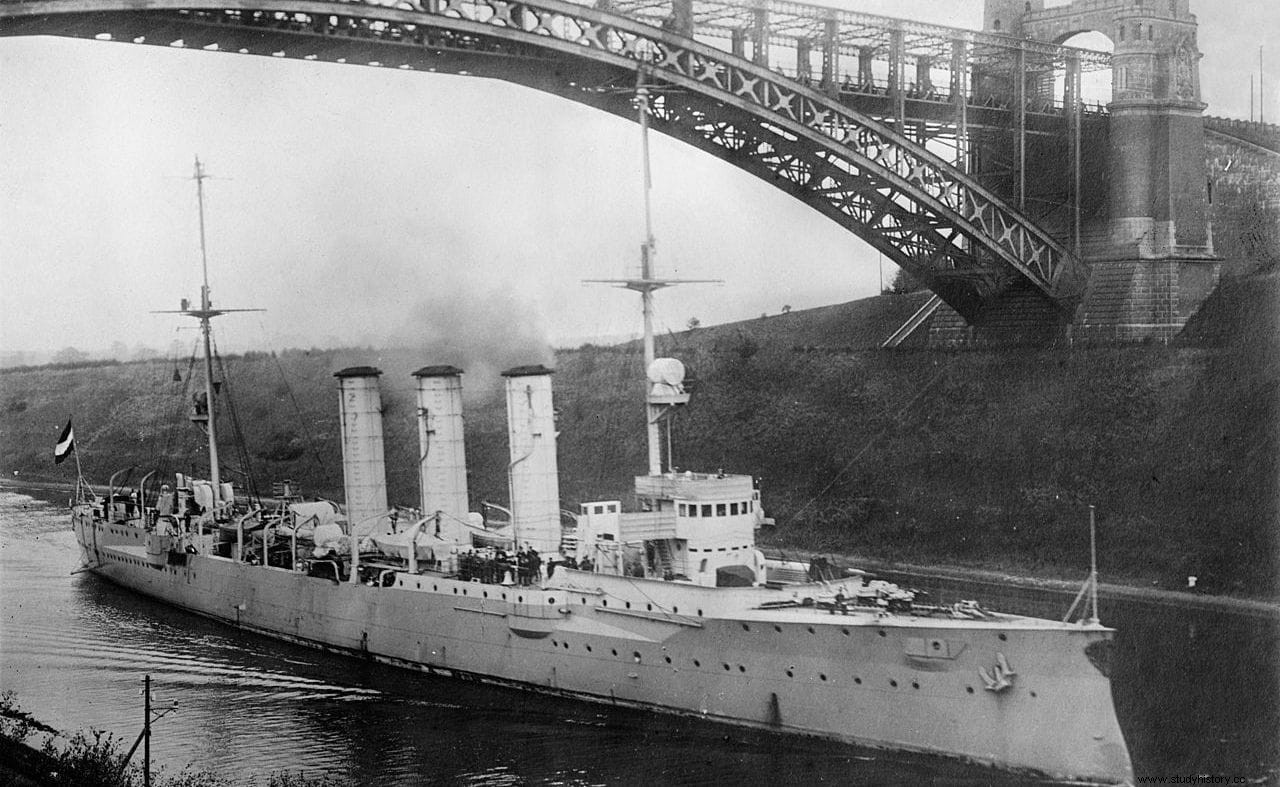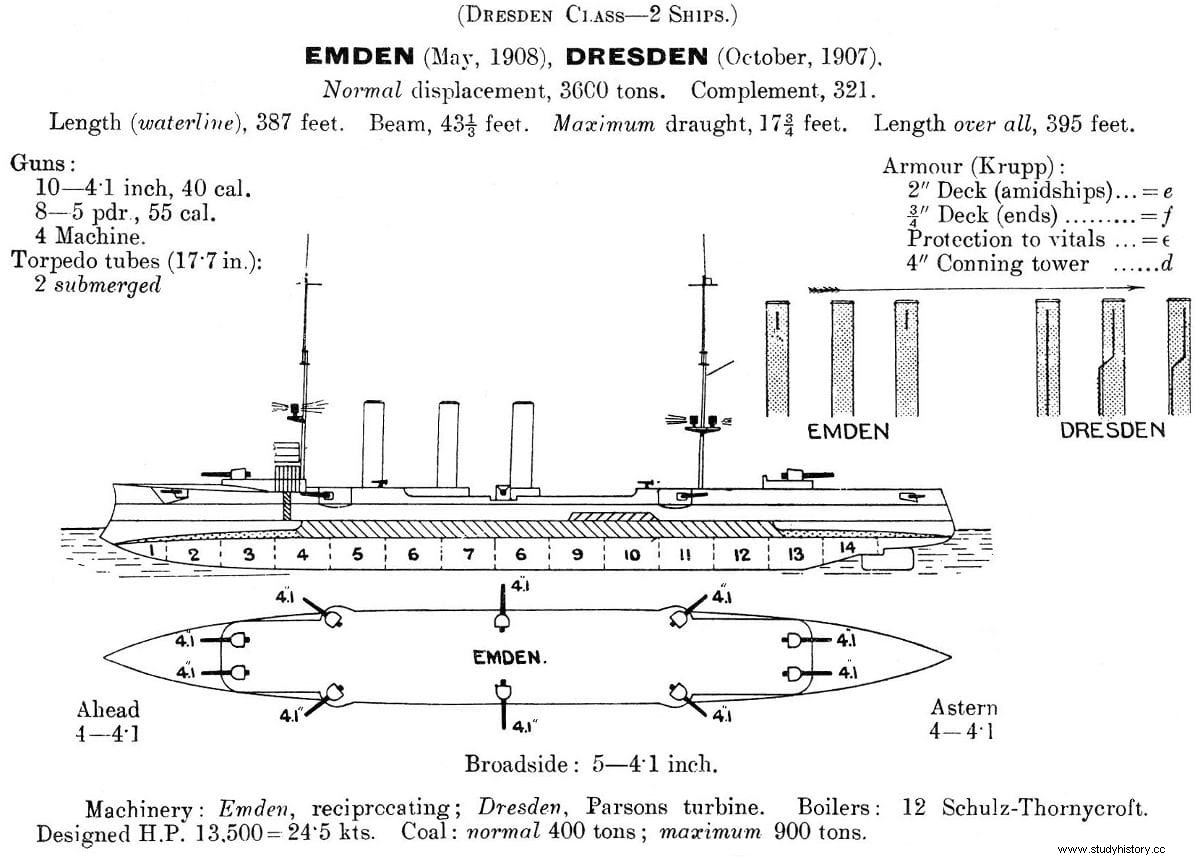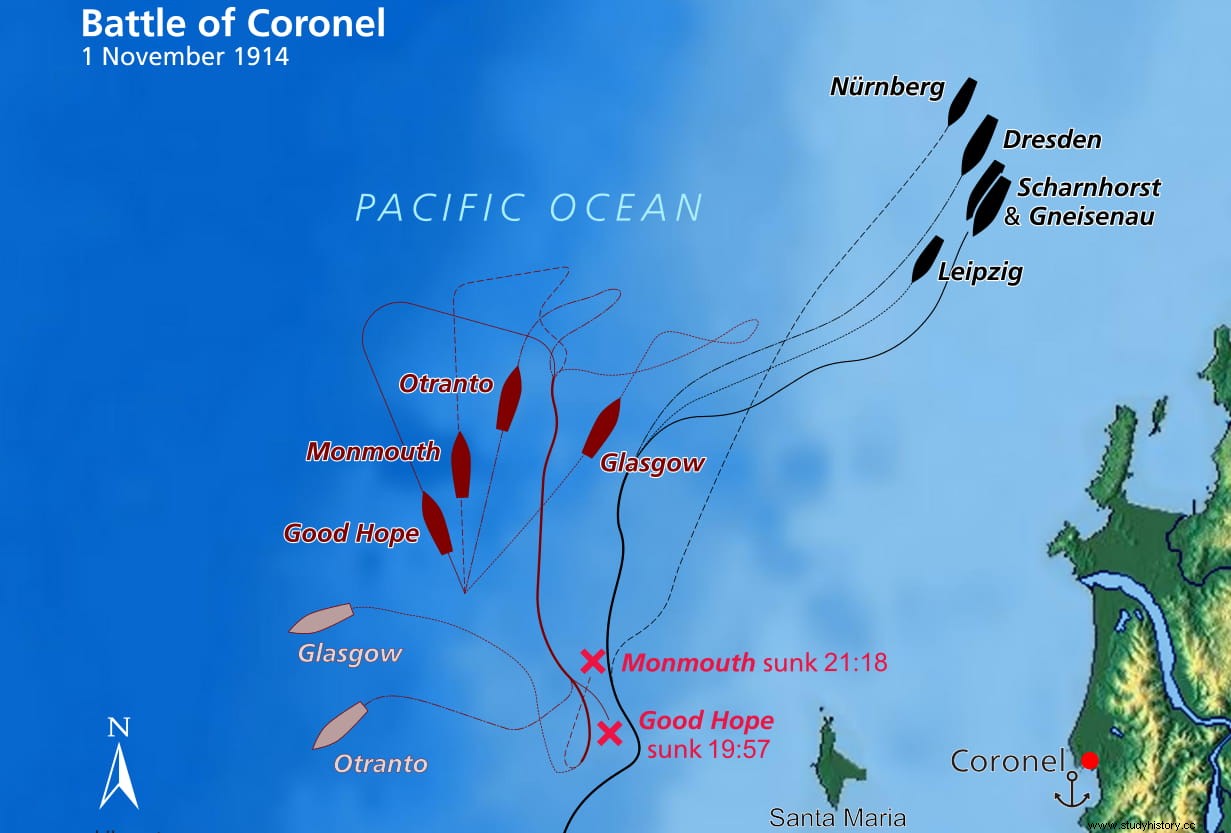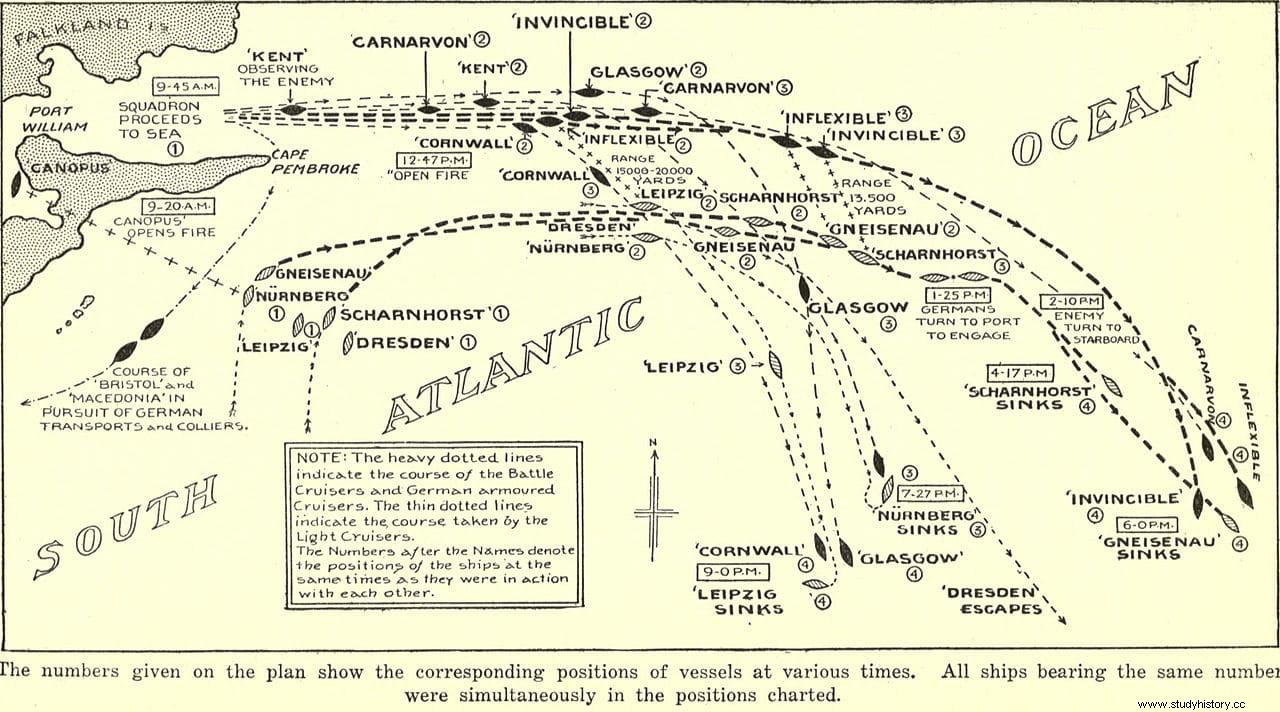A few months ago we dedicated an article to tell the exciting story of the SMS Emden , a ship of the German Imperial Navy that during the First World War was dedicated to practicing privateering in the Indian Ocean, constituting a nightmare for the enemy until the cruiser HMS Sidney of the Royal Navy surprised and destroyed it with cannon fire. Well, the SMS Emden she was the second ship of the homonymous class, the first being the SMS Dresden , whose story is equally full of adventure... and also an exciting mystery.
Launched in Hamburg on October 1, 1907, it was a light cruiser that measured 118.3 meters long by 13.4 wide and 5.55 deep, displacing a maximum of 4,268 tons and having a dozen 105-pound guns. mm, 8 of 52 mm and a pair of torpedo tubes. What differentiated this unit from her twin was that she was powered by turbines, instead of conventional piston engines, which drove 4 propellers, which allowed her to reach higher speeds:up to 28 knots.

If the history of navigation is synonymous with adventure, the history of Despon sublimates that concept and is full of anecdotes. Obviously, the war was the decisive factor in that sense, but earlier, during the first sea trials, he suffered a strange experience:colliding with another ship, Swedish to be exact, which delayed his entry into service by six months... but then there was a problem with a turbine and this caused another delay of four more months.
She was eventually sent to the US to represent Germany at the Hudson-Fulton Celebration in New York, later being assigned to a squad with which she conducted naval exercises for two years. During one of them, incredible as it may seem, she collided with another ship, the SMS Königsberg .

Not everything was negative. The SMS Dresden she won the Kaiser's Schießpreis, a marksmanship competition, and in 1913 was posted to the Mittelmeer-Division (Mediterranean Division), where she stayed for several months until she returned to the shipyards for an overhaul. After this and when the crew was preparing to return to the Adriatic, she received a counterorder:the ship had to go to Mexico to protect German interests in the revolutionary context that existed there, as other countries did. Accompanied by Hertha and the Bremen , and carrying Lieutenant Wilhelm Canaris (future director of the intelligence services of the Third Reich) among the crew, was used to transfer the resident German citizens, although he also collaborated in saving a thousand Americans trapped in Veracruz and in facilitate the arrival of a shipment of weapons for President Victoriano Huerta, an ally of the Kaiser in those pre-war times.
Frigate Captain Fritz Lüdecke then arrived to take command. Polish by birth, he was an artillery specialist and who was in charge of removing Huerta when he was overthrown, leaving him in Jamaica. That's where they were when the First World War broke out and the ship was ordered to stay in America with the mission of operating in those waters. Lüdecke proceeded to Brazil, where he carried out his first action on August 6 capturing a British freighter, the SS Drumcliffe , whom he chivalrously released because he hadn't heard the news. From then on, the sinking of enemies followed one another, with the support of a coal ship, a gunboat and several support ships.

She then crossed the Strait of Magellan to join Easter Island, just like the Leipzig , to the Asian squadron of Vice Admiral Maximilian Graf Von Spee, which had crossed the Pacific from Tsingtao (China) and was composed of the battleships Scharnhorst and Gneisenau , plus the light cruiser Nürnberg (other units had split off to operate on their own). At the end of October they headed from Valparaíso to the Chilean port of Coronel to attack a British light cruiser anchored there, the HMS Glasgow . But the information handled by Von Spee was incomplete because that ship was not alone but accompanied by three others, the battleships Mommouth and Good Hope , and the auxiliary transept Otranto .
The ensuing battle was fought on November 1, so apart from the name Colonel it is also known as All Saints' Day. The German squadron was superior to the British, led by Admiral Christopher Cradock, who was denied reinforcements, which made the Teutons victorious:the Good Hope and the Mommouth they sank and the sea engulfed 1,654 sailors, since bad weather prevented their rescue.

That left those latitudes in the hands of the Kaiserliche Marine and that convinced the British Admiralty that Cradock was indeed right to ask for help. Accordingly, the cruisers HMS Invincible were sent , HMS Inflexible and HMS Kent under the command of Vice Admiral Frederick Doveton Sturdee.
In the Falkland Islands they joined the armored cruisers Cornwall , Kent and Carnarvon , and light cruisers Glasgow and Bristol , plus an obsolete ship called HMS Canopus . Towards the archipelago was headed Von Spee, who, unaware of the formidable squad that awaited him, had the objective of destroying the Port Stanley telegraph station and the coal store, although Lüdecke and other captains did not agree with the plan. The encounter took place on December 8:discovering the almighty enemy, Von Spee ordered to turn around but the British launched themselves in pursuit and caught up with the Germans.
The famous Teutonic admiral tried to protect the retreating light cruisers with battleships and went to the bottom of the sea with the Scharnhorst (His two children also died). The captain of the Gneisenau , faced with an unequal confrontation with three ships, sank his while the Leipzig , engulfed in flames, was torn to pieces by Glasgow artillery and the Cornwall , at the same time that his sailors opened the valves. For its part, the Nürnberg tried to ram the Kent , who let him get close to pulverize him with cannon fire.

Only the Dresden she was able to escape thanks to the power of her turbines, giving her pursuers the slip in the labyrinth of channels of Chilean Patagonia. She later looked for a port where she could coal and repair the damage. But under international law he could only stay as long as he needed to, and since it was impossible to return to Germany with the Royal Navy cut off, Lüdecke had the idea of crossing the Pacific. However, his coal reserves were running low and the engines began to fail, so in early March he anchored in the Juan Fernández archipelago. There he was surprised on the 14th by a British squadron made up of the HMS Kent , HMS Orama and HMS Glasgow .
Unable to fight, being immobile, Lüdecke sent Lieutenant Canaris to parley. But he was ignored and the cannonade began, so the captain landed his men, opened the valves and detonated the magazine, sinking the cruiser. The sailors were interned for the rest of the war except for three who managed to escape, including Canaris. I had finished the story of the SMS Dresden but the legend began, because it didn't take long for rumors to appear about what had happened to the riches that she allegedly had on board.

The wreck of the cruiser is half a kilometer from land, in Cumberland Bay, resting on its starboard side in two hundred feet of water. Thanks to the clarity of the waters, the divers have managed to rescue several pieces, such as the bronze bell. But, without a doubt, the most suggestive thing, what unleashes the feverish imagination of almost everyone, is the aforementioned treasure:cash, jewelry and all kinds of valuables from the Germans residing in Mexico, who had deposited them in the ship anchored in Tampico to be transferred to Germany; also a fortune in Chinese gold coins from Tsingtao. Is all that at the bottom of the sea or could it have been removed before?
In the Teutonic colony of Puerto Montt, in the Chilean region of Los Lagos, it is said that some of her ancestors were aboard the Dresden carrying supplies when she hid from the British in a local fjord called Quintupeu. It is a narrow sea inlet, wedged between huge 600-meter-high cliffs that was very suitable as a hiding place, as two Teutons living in Punta Arenas, Albert Pagels and Harry Rothemburg, had informed Lüdecke. Well, some said that with the repairs completed and the path cleared of British ships, the cruiser prepared to resume its march, but first it threw a large crate into the water.

Speculations about its content are easily deductible. However, the legion of adventurers who have been searching for him since then have failed. The questions of yesteryear are still present today:what did that enigmatic drawer contain? Could it be the treasure? Where can this be, in the fjord or in the wreck? Does it really exist or is it the fruit of the imagination?
